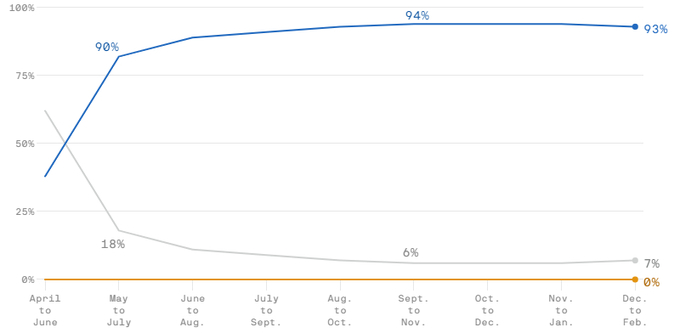November 27, 2025 | 03:56 GMT +7
November 27, 2025 | 03:56 GMT +7
Hotline: 0913.378.918
November 27, 2025 | 03:56 GMT +7
Hotline: 0913.378.918

Data: NOAA; Chart: Axios Visuals
The big picture: It could lead to the first year in which the global average surface temperatures bump up against the Paris Agreement's more stringent climate change target of 1.5°C (2.7°F) above preindustrial levels, Zeke Hausfather, climate research lead at payments company Stripe, told Axios.
The waters of the equatorial tropical Pacific Ocean are warming quickly, and at least a moderate El Niño is expected to begin during the May through July period and continue into the Northern Hemisphere winter, NOAA stated Thursday.
The new outlook cites several trends for having increased confidence in El Niño's formation and intensity compared to just one month ago.
These include the increasing sea surface temperatures as well as the presence of unusually warm waters beneath the surface, which are sloshing from the Western Pacific eastward; and shifting trade winds.
In addition, computer model projections have grown steadily more bullish on both El Niño's development and intensity.
By the numbers: The odds of El Niño forming through July and lasting into the Northern Hemisphere winter are now at 82%, with above 90% odds later this summer, NOAA found.
This is up from just above 60% odds for the May through July period provided in April's forecast.
The odds of at least a moderate El Niño at the end of the year are pegged at 80%, with about a 55% chance of a strong El Niño event.
Yes, but: Forecasters at NOAA's Climate Prediction Center assigned just a 5% to 10% chance that an El Niño will not occur, due to potential miscues between the ocean and atmosphere.
For the climate cycle to develop, changes in atmospheric and ocean conditions need to reinforce each other in a complex series of events.
Threat level: Global ocean surface temperatures have been off the charts in recent months, a trend linked to El Niño's formation.
El Niño events are naturally occurring, and the added ocean heat, some of which gets transferred into the atmosphere, serves to temporarily accelerate the rate of human-caused climate change.
The last record warm year occurred in 2016, which also featured a strong El Niño.
The planet has continued to warm since: The past eight years were the warmest eight years on record.
This positions 2023 and 2024 well for coming close to or breaking new benchmarks.
What they're saying: "A moderate to strong El Niño substantially increases the chance that 2024 will be the warmest year on record, and the odds that it might be the first year to surpass 1.5°C," Hausfather said in an email.
This would be a symbolic milestone, since the Paris Agreement's target concerns long-term warming, not a single year.
Between the lines: El Niño shifts weather across the globe, squelching much-needed rains for millions, and causing floods in other regions.
It is well known for drying out Australia and parts of Oceania, increasing wildfire risks. It can also yield wetter than average conditions in East Africa, which is currently stuck in a deadly drought.
Its impacts on North American weather tend to be maximized during the fall and winter.
El Niño years are also tied to coral bleaching events, said Kim Cobb, director of the Institute at Brown for Environment and Society.
"Given that the last two major El Niño events — in 1998 and 2016 — each broke records for global-scale coral bleaching and mortality, this coming El Niño event poses a grave threat to coral reef ecosystems around the world," she told Axios in an email.
The bottom line: Buckle up, as El Niño is likely to bring more extreme weather events worldwide, along with a pronounced spike in warming.
(axios)

(VAN) A new study reveals how the simultaneous effects of ocean acidification, salinity and loss of oxygen are making the world more fragile.

(VAN) Hopes are growing that the creation of the first 3D turkey gut model could be a turning point in the battle against the virulent blackhead disease.

(VAN) Tyson, America’s biggest meat supplier, plans to shutter one of its largest beef processing plants as the industry continues to struggle with low cattle supplies and political pressure from Washington.

(VAN) New FAO study shows how digital solutions are empowering farmers and fishers to prevent losses and build resilient agrifood systems.

(VAN) Brazil's COP30 presidency pushed through a compromise climate deal on Saturday that would boost finance for poor nations coping with global warming but that omitted any mention of the fossil fuels driving it.

(VAN) Poultry farmers in the UK have been warned that they could face one of the worst winters yet for bird flu.

(VAN) Prices of main-crop paddy have risen sharply, with jasmine rice hitting 16,100 baht per tonne — the highest level in years.